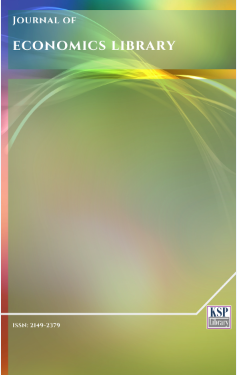Private Consumption in Sweden and Finland Before, During and After the Global Financial Crisis
Abstract
Abstract. This study describes private consumption in Sweden and Finland before, during and after the Global Financial crisis. During eleven years, from 2004 to 2013, we investigate how the total household consumption expenditures have developed and how households have allocated their consumption budgets on various consumption categories in the two Nordic countries. The research design is of descriptive character and the data is derived from Statistics Finland and Statistics Sweden. The key findings of the study are: (1) The private consumption continued to grow in both countries, with the exception in Finlandin 2009. (2) Both the actual decrease in consumption and the reallocation of commodities indicate that Finnish households have suffered more from the Global Financial Crisis compared to Swedish ones.
Keywords. Private consumption, household expenditures, financial crisis, Finland, Sweden.
JEL. D12, G01, O57.
References
Baily, M.N., & Eliott, D.J. (2009). The US financial and economic crisis: Where does it stand and where do we go from here. Intiative on Business and Public Policy, Brooklings.
Baxter, J.L. & Moosa, I.A. (1996). The consumption function: A basic needs hypothesis. Journal of Economic Behavior & Organization, 31(1), 85-100. doi. 10.1016/S0167-2681(96)00866-9
Deaton, A. & Muellbauer, J. (1980). Economics and Consumer Behavior, Cambridge University Press.
Du, R.Y. & Kamakura, W.A. (2008). Where did all that money go? Understanding how consumers allocate their consumption budget. Journal of Marketing, 72(6), 109-131. doi. 10.1509/jmkg.72.6.109
Edey, M. (2009). The global financial crisis and its effects. Journal of Applied Economics and Policy, 28(3), 186–195. doi. 10.1111/j.1759-3441.2009.00032.x
Etzioni, A. (2011). The New Normal. Sociological Forum, 26(4), 779-789. doi. 10.1111/j.1573-7861.2011.01282.x
European Commission (2015).Macroeconomic imbalances Country Report-Sweden 2015. Occasional Papers, No.226, Publications Office of the European Union.
Hall, R. E. (1993). Macro Theory and the Recession of 1990–1991. American Economic Review, 83(2), 275-279.
Heffetz, O. (2011). A test of conspicuous consumption: Visibility and income elasticities, Review of Economics and Statistics, 93(4), 1101–1117. doi. 10.1162/REST_a_00116
Hurd, M. & Rohwedder, S. (2011). The Effects of the Financial Crisis on Actual and Anticipated Consumption. Michigan Retirement Research Center, University of Michigan.
Frank, R. (2014). Microeconomics and Behavior, Mcgraw-Hill.
Jappelli, T. & Pistaferri, L. (2010). The Consumption Response to Income Changes. NBER Working Paper No.w15739, CambridgeUniversity. doi. 10.3386/w15739
Kamakura, W.A. & Du, R.Y. (2012). How economic contractions and expansions affect expenditure patterns. Journal of Consumer Research, 39(2), 229-247. doi. 10.1086/662611
Korkman, S. & Suvanto, A. (2014). Finland and Sweden in Cross-Country Comparison: What are the Lessons? In T. Andersen, M. Bergman and S. Hougaard Jensen (Eds.), Reform Capacity and Macroeconomic Performance in the Nordic Countries, (pp.278–305).Oxford University Press.
Parker, J. & Vissing-Jorgensen, A. (2009). Who Bears Aggregate Fluctuations and How? NBER Working Paper No.W14665, Cambridge University. doi. 10.3386/w14665
Raijas, A. & Varjonen, J. (2013). Finska konsumtionsmönster. In J. M. Roos (Eds.). Konsumtionsrapporten 2013(pp. 35-40). Centre for Consumer Science, University of Gothenburg.
Reuters (2009). Three top economists agree 2009 worst financial crisis since great depression; Risks increase if right steps are not taken.
Roos, J. M. (2011). Konsumtionsrapporten 2011. Centre for Consumer Science, University of Gothenburg.
Roos, J.M. (2013). Konsumtionsrapporten 2013. Centre for Consumer Science, University of Gothenburg.
Simon, H. (2009). The crisis and customer behaviour: eight quick solutions. Journal of Customer Behaviour, 8(2), 177-186. Doi. 10.1362/147539209X459796
Solér, C. (2010). Vid ekonomisk oro undviks risker. In J. M. Roos (Eds.), Konsumtionsrapporten 2010 (pp. 31-32). Centre for Consumer Science, University of Gothenburg.
Statistics Finland (2014). Private final consumption expenditures at reference year 2010 prices.[Cited 21.09.2014] Retrieved at http://www.stat.fi/til/tul_en.html
Statistics Sweden (2004).Priavate final consumption expenditures at reference year 2010 prices. [Cited 21.09.2014] Retrieved at http://www.scb.se/sv_/Hitta-statistik/Historisk-statistik/Utvalda-kallor-efter-amne/Nationalrakenskaper
Stiglitz, J.E. & Walsh, C.E. (2006). Economics, Norton & Company.
Suoniemi, I. & Sullström, R. (1995). The Structure of Household Consumption in Finland 1966–1990. ResearchReports 27. Helsinki, Valtion taloudellinen tutkimuskeskus VATT.
Wickelgren, M. (2011). Biltransporter – vår käraste utgift? In J. M. Roos (Eds.), Konsumtionsrapporten2011 (pp. 22-25). Centre for Consumer Science, University of Gothenburg.
The World Bank (2014).Household final consumption expenditure, etc. (% of GDP).[Cited 21.07.2014]. Retrieved at http://data.worldbank.org/indicator/v NE.CON.PETC.ZS
DOI: http://dx.doi.org/10.1453/jel.v2i4.432
Refbacks
- There are currently no refbacks.
.......................................................................................................................................................................................................................................................................................................................................
Journal of Economics Library - J. Econ. Lib. - JEL - www.kspjournals.org
ISSN: 2149-2379
Editor: [email protected] Secretarial: [email protected] Istanbul - Turkey.
Copyright © KSP Library

